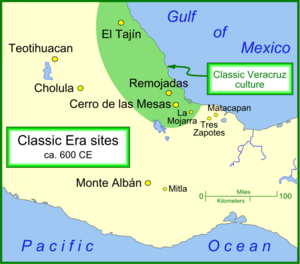Cerro de las Mesas facts for kids

Cerro de las Mesas means "hill of the altars" in Spanish. It is an important archaeological site located in the Mexican state of Veracruz. This ancient city was a major center in its region from about 600 BCE to 900 CE. It even served as a regional capital between 300 CE and 600 CE.
Cerro de las Mesas is about 50 km (31 mi) south of Veracruz City. It sits on the edge of what was once the heartland of the ancient Olmec civilization. After the Olmec culture declined, Cerro de las Mesas became very important. Many experts believe it was a key place for the Epi-Olmec culture. This culture came after the Olmecs and later led to the Classic Veracruz culture around 300 CE.
What You Can Find at Cerro de las Mesas
The site has a man-made lagoon and hundreds of artificial mounds. These mounds are often found in groups, usually with one long mound and one cone-shaped mound. Most of these mound groups were likely built during the Epi-Olmec period, from 400 BCE to 300 CE. During this time, you can also see signs of influence from the powerful city of Teotihuacan in the archaeological finds.
Later, during the Classic period, something special was found. A hidden collection of about 800 jade items was buried at the base of the largest mound. Some of these jade pieces were very old, dating back hundreds of years to the Olmec civilization. They were likely offerings to the gods.
Special Stone Carvings (Stelae)
Cerro de las Mesas is famous for its many stele. These are tall, artistic stone slabs, and many of them have carved portraits. Four of these stelae (numbers 5, 6, 8, and 15) are especially important. They contain what experts believe are examples of Epi-Olmec or Isthmian script. This ancient writing system gives us clues about the people who lived there long ago.
See also
 In Spanish: Cerro de las Mesas para niños
In Spanish: Cerro de las Mesas para niños


